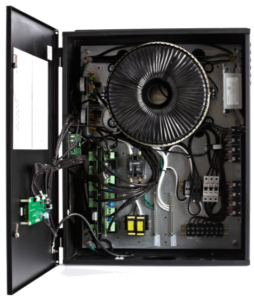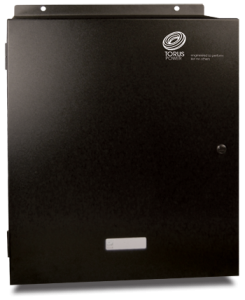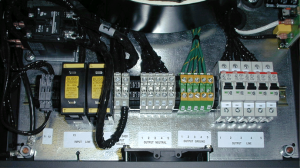 It all starts at the wall. How many times have you heard that? It means, of course, that the sound you hear coming from your speakers will have been greatly influenced — positively or negatively — by your home’s AC power before there is even a musical signal to be reproduced.
It all starts at the wall. How many times have you heard that? It means, of course, that the sound you hear coming from your speakers will have been greatly influenced — positively or negatively — by your home’s AC power before there is even a musical signal to be reproduced.
I think there’s little debate these days regarding the efficacy of clean power for high-end audio systems. But there’s still lively conversation among audiophiles about how precisely to get that clean power. After researching the subject and speaking with several experts, I came to believe that the best solution for TWBAS 2012 was to address power quality on what I believe to be a more fundamental level: Fix it before it even gets to the wall outlets.
That mandate led me directly to Canada’s Torus Power.

Torus Power makes a line of Power Transformers for home, studio, and professional audio/video systems. Their products range from component-type conditioners that you can place on your rack, to full-out, wall-mounted electrical panels that can feed AC to your whole room. Torus Power is a division of Plitron Manufacturing, makers of what seems an endless array of toroidal power transformers for all types of applications. In fact, a slew of high-end audio manufacturers use Plitron transformers in their products’ power supplies, among them Bryston. You may have a Plitron transformer in your system right now and not even know it. I think it’s safe to say that Torus, being at heart a maker of transformers, has a DNA-level advantage in understanding the fundamental science of clean electrical power.
The best place to start exploring Torus is to read the company mission, stated on their website’s home page: “using Toroidal Isolation transformers that also act as noise filters — to provide the cleanest possible AC power.” Whereas most Power Transformers are passive devices designed to filter the power coming from your AC outlet, just before it reaches your system, the Torus products act differently, and at a different link in the chain. Torus conditioners don’t simply filter out noise for the components connected to them, but essentially isolate your electronics from the power grid through the use of Low Noise (LoNo) balanced isolation transformers. According to Torus, these transformers “attenuate differential and common-mode noise, eliminating requirements for external circuits such as low-pass filters.” These low-pass filters are what comprise most passive Power Transformers. Torus explains the problems that their products address:
Although a virtually pure sine wave at the generated source, non-linear loads and asymmetries encountered during transmission radiate emissions back onto the common grid, and power arriving at the load is contaminated with harmonic distortion and various unwanted electrical noises.
 Torus Power’s simple, advanced but elegant solution resolves incoming power quality problems by harnessing the transformers’ combined inherent inductance, capacitances, and resistance characteristics to act as a filter, thus exceptionally high levels of attenuation are attained with absolutely no reliance on any external components. Through the elimination of filters, series inductors, shunt capacitors, or other passive reactive devices commonly required in the power circuit, Torus products start with a noise floor at the theoretically lowest level.
Torus Power’s simple, advanced but elegant solution resolves incoming power quality problems by harnessing the transformers’ combined inherent inductance, capacitances, and resistance characteristics to act as a filter, thus exceptionally high levels of attenuation are attained with absolutely no reliance on any external components. Through the elimination of filters, series inductors, shunt capacitors, or other passive reactive devices commonly required in the power circuit, Torus products start with a noise floor at the theoretically lowest level.
For TWBAS 2012, Torus recommended their WM100 BAL (27″W x 10.5″H x 20.5″D, 228 pounds, $8550 USD), a 100-amp, wall-mounted electrical panel that will replace the 90-amp subpanel in my Music Vault listening room. The WM100 BAL operates by accepting a 240V balanced input from the house’s main 200A service, then outputting 120V/60Hz, the requirement for North American households. The massive balanced isolation transformer inside the WM100 BAL accounts for the vast bulk of its weight (as is the case with all Torus products).
The degree of surge suppression provided by Torus Power Transformers is impressive: Components are protected via series-mode suppression that absorbs any surge more than 2V above the peak line voltage. The WM100 BAL is rated “to withstand 6000 volts, 3000 amps for 1000 repeats.” How does this way of suppressing line surges differ from more traditional power conditioning? According to Torus, their products allow “for the replacement of a series inductor [as is found in most Power Transformers — Ed.] with the Torus isolation transformer. The transformer has lower stray fields and higher current capabilities than the typical series inductor. Most surge-suppression circuits are shunt-mode. Excessive voltage surges are ‘shunted’ to ground, which raises ground voltage and may contaminate audio and video signals. Shunt-mode surge protectors usually use MOVs (metal oxide varistors) which are sacrificial components, and usually become ineffective over time.”
 Howard Gladstone, Torus Power’s president, mentioned to me another benefit of the Torus products that is especially beneficial to a large system like TWBAS 2012: “the instantaneous high-current capability that Torus provides. This performance feature is provided by the Torus no-compromise approach to the design of Toroidal Isolation transformers, based on experience gained over 30 years of supplying the high-end audio industry. An amplifier connected to a Torus unit will have sufficient power — delivered and available instantaneously — to be able to meet any peak demand in the audio source without strain. No system using filters can provide this. The result manifests in so many ways: increased dynamic range, more realism, sense of ease, less strain, less coloration, etc.”
Howard Gladstone, Torus Power’s president, mentioned to me another benefit of the Torus products that is especially beneficial to a large system like TWBAS 2012: “the instantaneous high-current capability that Torus provides. This performance feature is provided by the Torus no-compromise approach to the design of Toroidal Isolation transformers, based on experience gained over 30 years of supplying the high-end audio industry. An amplifier connected to a Torus unit will have sufficient power — delivered and available instantaneously — to be able to meet any peak demand in the audio source without strain. No system using filters can provide this. The result manifests in so many ways: increased dynamic range, more realism, sense of ease, less strain, less coloration, etc.”
The WM100 BAL will feed my entire room’s wall outlets, including the two dedicated 20A lines that feed the audio system. With this arrangement I’ll also gain power conditioning for all the wall outlets around the room, even those that were installed just to meet local electrical codes. As for performance, Torus is very straightforward about what their products do. The WM100 BAL “performs as a low-pass filter, attenuating noise from 2kHz to 1mHz, with attenuation of 12dB/decade to 500kHz.” Note that the WM100 BAL is not to be installed by the buyer — unless that buyer is a licensed electrician.
Although the WM100 BAL could be considered overkill for many systems, this is TWBAS — overkill is just enough. Even so, we’ve decided to add one more component to the mix, to supply power to the source components alone: a Torus RM 20 AVR power transformer (19″W x 6.25″H x 22.25″D, 100 pounds, $4300), based on the same principles and technologies as the WM100 BAL. The RM 20 AVR will completely isolate the digital components from the analog amplification. It also will keep the voltage feeding the gear plugged into it at a set 120V, +/-5V, through the use of a microprocessor circuit that monitors and controls the incoming voltage. The RM 20 AVR also provides surge suppression (although in this installation, that will already have been handled by the WM100 BAL). The RM 20 AVR has ten medical-grade outlets on its rear panel, a 20A circuit breaker on the front, and the same noise-filtration specifications as the WM100 BAL. Even if you can’t spring for a WM100 BAL, you can get the benefits of Torus Power’s balanced isolation transformer by plugging an RM 20 AVR into your wall, and all of your gear into the Torus.
Just the right thing to do
There just seems to be something more inherently right about correcting power-line anomalies before they reach your room’s outlets. It’s equivalent to treating the source of a disease instead of merely the symptoms. I’m sure some will quibble with that analogy, particularly companies that manufacture only passive Power Transformers that plug into wall outlets. But why not correct the power sooner rather than later?
The Torus Power WM100 BAL and RM 20 AVR take the concept of low-noise audio performance to its logical apex. Their Narrow-Bandwidth Technology (NBT) attenuates “differential and common-mode noise without external circuits or components.” Many audiophiles work to reduce noise in their systems through the use of balanced connections, vibration isolation, proper routing of cables, etc. But shouldn’t clean power be the real beginning? Torus is keen to show how their transformers literally transform distortion-laden AC from the wall outlet, so that it emerges scrubbed clean. (One measurement graph on their site illustrates the results: After filtering by a Torus unit, AC with a noise level of 172MVDC direct from the wall was rendered virtually free of distortion, with only 1MVDC of noise.)
Another analogy: Speaker companies that make their own drive-units earn more street cred than companies that buy stock drivers from other manufacturers. Because it takes serious expertise to engineer a really good drive-unit, it stands to reason that that same expertise can be leveraged to engineer a superior finished loudspeaker. In that vein, Torus Power and Plitron Manufacturing have the fundamental engineering know-how to address the quality of AC power in a high-end audio system in a more from-the-ground-up fashion than most. To my eyes, eliminating guesswork and putting the power quality of TWBAS 2012 in the hands of Torus Power is the right move. I’m confident my ears will agree.
. . . Jeff Fritz jeff@soundstagenetwork.com
